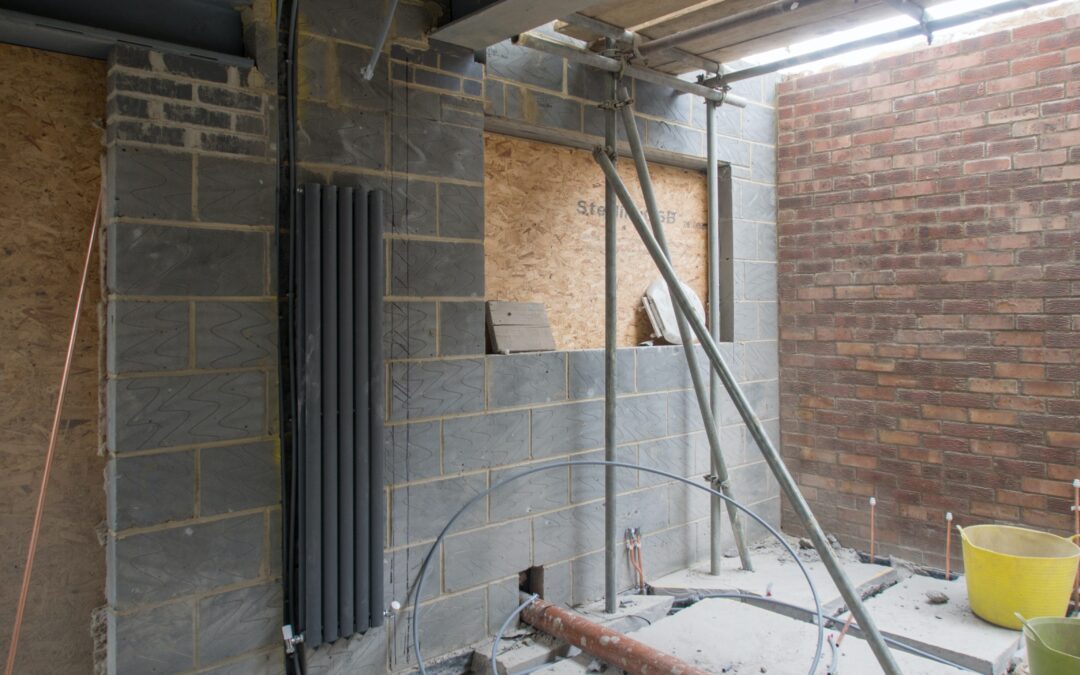This type of insurance coverage is designed to cover one specific part of a construction or remodeling project — such as roofing, concrete, plumbing, HVAC systems, solar panels, or cabinets, among others — and is available to both residential and commercial subcontractors and service providers.
The Oregon Contractors Resource Center has partnered with agents that have access to Oregon’s top builders risk programs, and they receive questions from builders across Oregon on the topic of installation insurance. In this resource, we answer some of their most common questions so you can confidently ensure your vision is properly protected throughout the course of construction.

Nuts and Bolts
Q: What is the difference between installation coverage and builders risk coverage?
A: At its core, installation coverage is nearly identical to builders risk coverage. The key difference lies in the scope of what is insured. Builders risk insurance is intended to cover everything going into a new structure from the ground up, insuring equipment and materials being constructed, installed, or erected at the project site. In contrast, installation coverage is designed to protect one single aspect of the project, such as the installation of bathroom fixtures, windows, air conditioning, etc. Installation policies also protect materials and fixtures to be installed while they are in transit.
Q: What type of contractor would benefit from installation coverage?
A: The ideal contractor for installation coverage is an artisan contractor, carpenter, plumber, electrician, HVAC technician, or another type of specialized contractor. General contractors can also purchase installation coverage. In certain circumstances, a property owner may also purchase installation coverage to make sure the materials are covered during installation. Installation coverage can be used to protect a variety of projects, too. In addition to things like cabinetry, fixtures, heating, air conditioning, and roofing, this type of insurance can also be used for the installation of cell towers, radio towers, fences, and more.
Q: Can more than one installation job be insured under the same policy?
A: If you are performing the same type of installation work and have multiple projects, coverage may be available under one blanket policy. This type of blanket policy is designed to cover all of the service providers’ jobs, subject to the terms and parameters of the policy. For instance, if an A/C contractor is installing air conditioning units at multiple schools in the same geographic area, the insured would benefit from a blanket installation floater designed to cover all of those jobs. With this approach, there is no need for the insured to take out separate policies for each installation.
Coverage and Policy Options
Q: When does coverage end on an installation floater?
A: It’s natural to assume that coverage will end as soon as the covered materials have been installed. However, not all policies end coverage at that point. In some cases, coverage extends until the subcontractor has been paid. In other cases, policy coverage may be available through the point when the installed materials become part of a larger structure. Because policies differ from carrier to carrier, it is important for insureds to read and understand coverage terms.
Q: Is soft-cost coverage recommended for my installation?
A: Soft cost coverage, designed to provide insurance protection for out-of-pocket expenses that the insured incurs as the result of a covered loss, is available as an optional policy endorsement for installation builders risk insurance. Generally, soft costs include things like added expenses for insurance, taxes, legal fees, permit and inspection fees, construction loan interest, etc. If the subcontractor or service provider is required to pay for eligible soft-cost items, adding this policy endorsement may be worthwhile. If, on the other hand, the subcontractor is not responsible for paying any soft-cost expenses, then this added coverage probably is not necessary.
Q: If I damage other property during the installation process, does the policy extend coverage to replace the property that was damaged?
A: Generally speaking, installation policies normally do not include liability coverage. If the subcontractor damages other property during the installation, he or she should review their liability insurance and any other policies to determine whether coverage is available.
Misconceptions
Q: Aren’t subcontractor materials already covered under the general contractor’s builders risk policy?
A: While the general contractor’s builders risk policy can extend coverage to subcontractors at the job site, not all coverage is provided to the subcontractor while materials are away from the project site. General builders risk insurance coverage may specifically exclude the subcontractor when overseeing materials or equipment in transit or at an offsite location. Because of that type of exclusion, subcontractors and service providers should consider having separate installation coverage to protect themselves rather than depending on coverage under another insured’s policy.
Q: Isn’t installation coverage the same across all carriers?
A: Unfortunately, there is no consistency across carriers when it comes to installation coverage. Some carriers offer broad form coverage, while others only offer installation coverage for named perils. Always review the policy form to confirm what perils are covered, to determine whether the policy provides for extensions or broadening of coverages, and to understand limitations and exclusions.
Q: Doesn’t a remodeling policy handle everything installation does?
A: The type of builders risk policy you’ll secure depends on what your client needs coverage to protect. Remember that installation policies just provide insurance for one specific project or type of material; remodeling coverage may be broader. If the contractor is responsible for remodeling beyond the installation of one specific material or piece of equipment such as in a kitchen or bathroom, they should have coverage for the entire project, as opposed to just coverage for installing new plumbing fixtures. Builders risk policies for remodeling projects offer expanded coverage to the entire project plans and possibly coverage for the existing structure.
Chances are that many of your existing customers have homeowners or other lines of insurance and are considering remodeling or renovating their existing structures. The information we shared here will help you educate your customers and better understand the requirements involved when insuring remodeling projects.
The Oregon Contractors Resource Center can connect you with the best agent that has the experience and expertise that you need to make sure your projects are protected.
For more guidance on insuring your course of construction projects, contact our dedicated team to get connected with the right insurance agent that focuses on the contracting industry.

